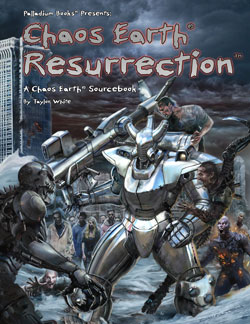
Palladium's flagship game, RIFTS, has a prequel line: Chaos Earth. CE focuses on the period immediately after the Coming of the Rifts, which is about 300 years before the default time of the main game. It's considered a playable stand-alone line, but in practice it's best considered a parallel line for the main game, and these products show it.
Again, we see the lagging indicator thing at play. This was a 2015 release, coming after the last major wave of zombie films and just as shows like The Walking Dead made their mark. Palladium loves their mashups, often giving the impression of being that guy at the all-you-can-eat buffet that throws all the things on one plate and ends up with a stack of food a good two inches tall, so it's no surprise that they decided to do the zombie apocalypse here.
The premise is that an extra-dimensional techno-necromantic construct--The Black Obelisk--pops up and begins doing techno-woowoo in the form of an elecromagnetic signal that makes all corpses animated and go all Night of the Living Dead in the area. Once scoured of people to kill, the dead scavage all useful tech and bits and take it back to the Obelisk. They they march inside and get necro-borged into killer zombie cyborgs with the ability to boost the Kill All Living signal, march forth and repeat; usual "stop it or all life on Earth dies" ensues.
To its credit, there is no pre-determined outcome this time. There are win conditions. There are loss conditions. Players have agency to determine the outcome. There are also extensive notes on using this with the main game as well as with the stand-alone zombie game in Palladium's roster, Dead Reign; this, along with the beastiary, is what gives the supplement its value.
If there is anything to criticize, it's that they spent a bit too much space explaining the antagonist--and there is one; this is not Le Mindless Horde--because so much of what drives this antagonist simply will not come up in play. It is unlikely that players will even know that a specific sentient individual runs this threat until they encounter him directly; the only use for knowing the antagonist's story is to give Game Masters a persona through which to filter Opposing Force actions, and that's done with just a terse psych profile of a paragraph or two. It worked for Walter B. Gibson; it works for you too.
A lighter criticism is too much space wasted on things players will never see, and Game Masters will not put on the table, such as narrative introductions. RPG products are technical manuals. Do not waste the user's time; get directly and immediately to the point. The supplement is an addon to a thing--a tool, a machine--that the user uses. Tell him what it is, how it works, and--and this is key--how to use it properly to achieve the desired effect. Be clean, be concise, be consistent; get in, get out, get on with it.
TLDR: Worth it if you play any of the three Palladium RPG aforementioned.
No comments:
Post a Comment
Anonymous comments are banned. Pick a name, and "Unknown" (et. al.) doesn't count.